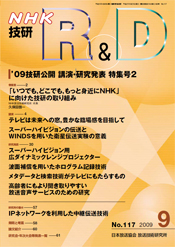
No.117 July 2009
Research Presentations
-
High Dynamic Range Projector for Super Hi-Vision
Yuichi KUSAKABE↓summary- summary
- We developed a projector which can display the high-resolution images of Super Hi-Vision(7,680×4,320 pixels)and has a high dynamic range of 1.1 million to 1.This projector features a serial combination of two modulation blocks:the first block for chrominance modulation and the second block for luminance modulation.This configuration enables the projector to output high-resolution color images by combining three low-resolution devices for chrominance modulation and one high-resolution device for luminance modulation.In addition,the dynamic range is dramatically improved because this dual modulation scheme minimizes the black levels in projected images.We demonstrated that our projector displays Super Hi-Vision color images and that it has an extremely high dynamic range of 1.1 million to 1 and fine tone reproduction.
-
Holographic Data Storage Technologies Using Wavefront Compensation
Norihiko ISHII↓summary- summary
- We are studying a holographic data storage system that uses wavefront compensation of the laser beam.In the writing procedure,phase fluctuations between the signal and reference beam prevent high-density recording.To alleviate this problem,the recording method sets a phase monitor near the recording medium and a piezo actuator on the reference path. Moreover,the reproduced image has a problem with its in-plane brightness distribution.To alleviate it,the reproduction method sets a deformable mirror on the reference path.Both methods improve SNR and are easy to use with a holographic data storage system.Our goal is to use these wavefront compensation technologies to develop a holographic storage system with a high enough storage density to record Super Hi-Vision programs.
-
How metadata and search technology change the TV viewing
Masanori SANO↓summary- summary
- Together with the development of IT technology,the integration of broadcasting and communications will yield an environment where users can easily access huge amounts of video content in various ways.TV will adapt incrementally to fit this new situation.One of the ways in which TV can evolve is "CurioView," a style of viewing which can satisfy users'curiosity by utilizing metadata attached to content and search and retrieval technologies.This paper describes the flexible and extensible design of the CurioView architecture and its trial
-
Research and Development of Acoustic Reproduction Methods Easier for Elderly Listeners
Tomoyasu KOMORI↓summary- summary
- Some elderly listeners find broadcasting narration to be too fast and background music ( BGM)to be too loud.To cope with this problem,NHK is researching acoustic reproduction methods that will make it easier for elderly viewers to hear speech in programs.We have already commercialized a TV/Radio set with a function to slow down the speech rate and have tested a sound mixing method to reduce the BGM level through an audio sub-channel in digital broadcasts.We are currently constructing a prototype device to assess objectively the best audio balance for the elderly.We also started to study effects of spatial multichannel sound reproduction on various listeners.This paper describes our research on these human friendly technologies and future perspectives for development.

